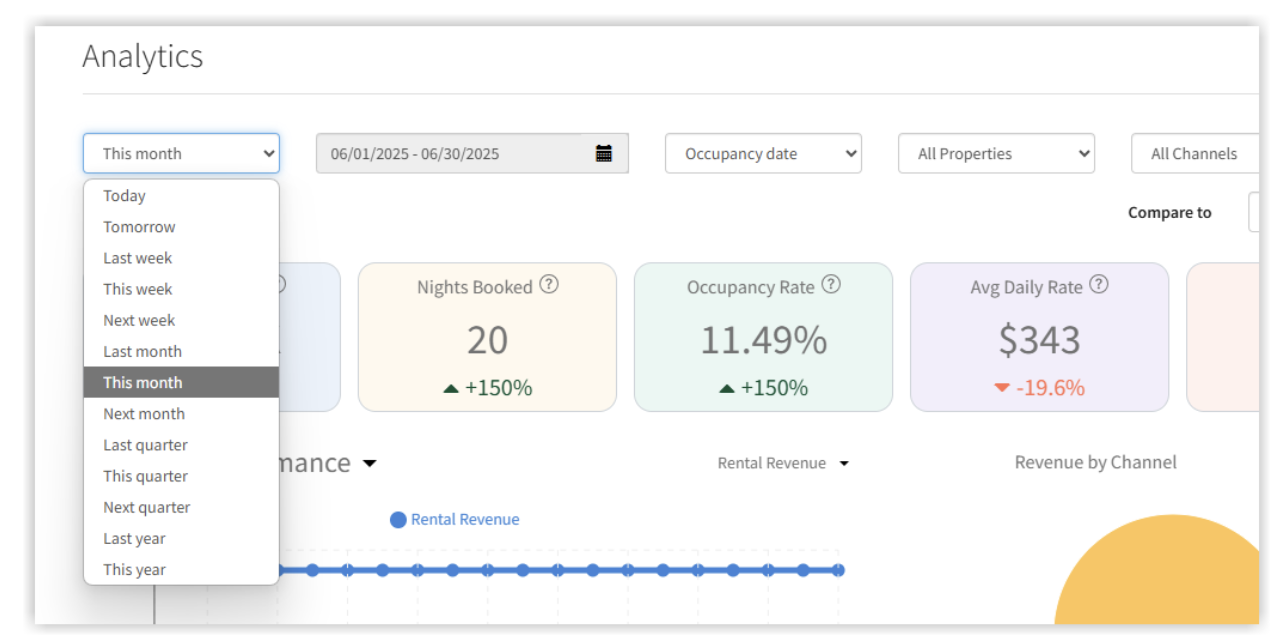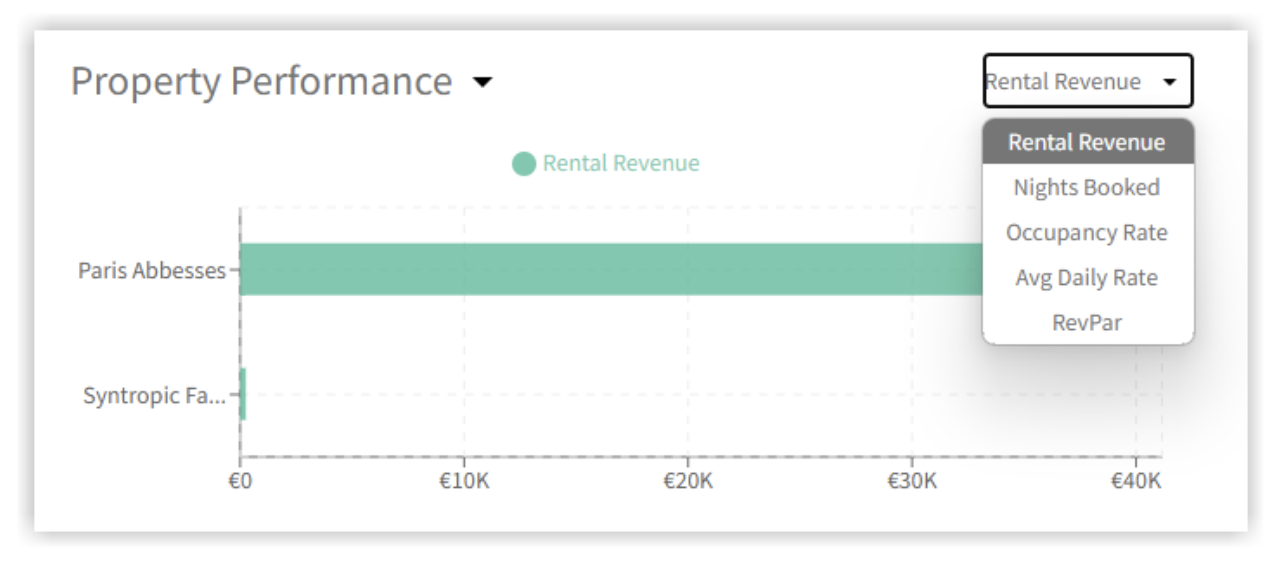Your calendar offers a general sense of how your Airbnb properties are performing, but without deeper insights, you don’t know whether they’re reaching their full earning potential.
Here’s the other thing: Airbnb analytics may not tell you everything you need to know. And with so many tools out there, how do you know which ones will bring value and which ones are just another expense?
The key is finding Airbnb analytics tools that not only reveal your business performance, but also indicate how you compare to competitors and whether you’re reaching your target market. Finding the right mix of tools can also help you optimize pricing, boost bookings, and scale your business with confidence.
In this guide, we break down the top Airbnb analytics tools and what each one offers. We’ve also spoken to Jun Zhou, founder of AirROI, for his expert insights on how to make the most of your tech stack.
What do we mean by Airbnb analytics tools?
Airbnb analytics tools are specialized software that help you monitor performance, filter and sort data, and visualize information. You use these to gain deep insights into popularity with guests, profitability, and much more besides.
These tools fall into four main categories:
- Native Airbnb analytics tools
- Airbnb marketing intelligence tools
- Dynamic pricing tools
- Property management systems (PMS) with in-built analytics
Any Airbnb host can benefit from Airbnb analytics tools. Homeowners renting out their house for the summer can use it to determine the most optimal times, small businesses can find opportunities for growth, and large vacation rental companies depend on it to keep track of all properties and channels.
Why do you need Airbnb analytics?
Airbnb analytics tell you where you’re doing well and where you need to improve. Without them, you’re likely to overlook issues like low occupancy rates and price mismatches before they escalate.
Insights also suggest ways to improve your profitability. For example, your calendar may be fully booked but you might spot ways to increase your average length of stay and reduce turnover costs.
But hosts can no longer rely on native tools. As Zhou says, “Airbnb’s dashboard is great for a quick pulse, but it only shows how you’re doing on Airbnb. It doesn’t tell you how your Vrbo or Booking.com listings are performing or whether your direct bookings are cannibalizing your OTA traffic. It also doesn’t show how your pricing stacks up against the guy next door.”
He adds that native Airbnb analytics still have a role to play. “I built AirROI to pull together all of that scattered data and turn it into one clear picture. The goal isn’t to replace Airbnb’s analytics, but to give hosts real visibility across channels so they can make better choices every day.”
What should you look for in an Airbnb analytics tool?
Airbnb analytics tools usually perform a range of functions. Here are the features you need to get a comprehensive yet in-depth look at your business performance:
- Real-time performance tracking: Tools should automatically record reservation data as you accept bookings, price properties, and collect guest reviews.
- A wide range of metrics: Great solutions not only track revenue and occupancy but also continuously analyze them to give you performance over time.
- Custom filters: You should be able to get a closer look at areas of your vacation rental business by selecting dates, channels, properties, and more.
- Visual dashboards: Raw data is difficult to read so tools must give you a choice of graphs and charts.
- Competitive benchmarking: It should be possible to compare metrics like pricing and occupancy to similar listings in your area to gauge performance.
- Deep integrations: All solutions must seamlessly connect to your Airbnb and other software to ensure you have all the possible data and it’s up to date.
“I’ve learned that without real-time data from Airbnb and your PMS, you’re always reacting late,” says Jun, “You can’t wait a day to know your calendar changed or your listing dropped off the front page. At AirROI, we built direct integrations so operators can see changes as they happen. This lets them adjust pricing, manage inventory, and spot patterns before they become problems. It turns your system into a living, breathing dashboard instead of a spreadsheet that’s already outdated.”
What are the best Airbnb analytics tools for hosts?
Let’s take a deeper look at the different types of Airbnb analytics tools and Airbnb management software with analytics capabilities and what actionable insights they can give you.
Airbnb native analytics tool
Airbnb includes a performance dashboard with every host account that displays metrics like occupancy, nightly rates, and earnings. You can filter this information by date and location for a closer analysis. Additionally, you can compare performance across different time frames and against nearby competitors.
But Airbnb’s standout feature is its ability to determine similar listings based on browsing patterns. Its algorithm can factor in what people looked at before booking your property. That means you’re seeing comparisons drawn from real user behavior, which can reveal competitors you might not have expected.
Airbnb data analytics and market intelligence tools

Some platforms offer you real-time market insights. For example, AirROI analyzes over 20 million global Airbnb listings and tracks regional metrics like:
- Historic and future demand
- Booking lead time
- Nightly rates
- Occupancy
- Revenue
- Inventory
Tools like these can also offer smart guidance on setting nightly rates. They use an algorithm to analyze market and competitor data and suggest an optimal price.
Compared with Airbnb, these dedicated platforms are significantly more in-depth. They cover a wider range of parameters and give you more ways to visualize the data so you can understand your performance. What’s more, many tools like AirROI are free to use and integrate with your tech stack via an API.
Dynamic pricing tools
Dynamic pricing tools calculate the best nightly rate for Airbnb listings based on current data and sync pricing everywhere. They have automation and bulk editing tools to enable you to adjust the amounts easily.
Additionally, many tools can automatically set pricing for orphan nights and different lead times based on market data and custom rules. For example, they can add discounts for last-minute gaps in your calendar in line with your usual lead times, current demand, and nearby competitor rates.
The main benefit of dynamic pricing tools is the time saving. Instead of having to research and manually adjust nightly rates to develop an Airbnb pricing strategy, you can let this software run in the background. But note that they usually require some setup to integrate and have a monthly subscription fee.
Here’s a look at all the dynamic pricing tools that Hostfully integrates with.
Property management system (PMS)

Property management software (PMS) integrates with your Airbnb and the rest of your tech stack to allow data to flow freely through your entire system. This lets you view and manage analytics in one place instead of jumping between different apps.
What’s more, leading PMS like Hostfully connect with hundreds of other popular OTAs and listing sites so you can compare performance across channels. You can easily filter by channel to see which one’s driving the most bookings and revenue. And if your Airbnb listings are underperforming, you can filter by dates and properties to explore why.
But PMS data analytics really stands out when it comes to overlooked areas of the business. Unlike most data analytics tools, they can pull information about team management, guest sentiment, and turnover to give you the most complete look at performance.
Which Airbnb metrics should you measure to gauge performance?
Airbnb analytics tools can tell you many things about how your property is performing if you know which metrics to follow. Here are the ones we’d recommend:
- RevPAR (Revenue per Available Room): Total revenue divided by the total number of nights your property was available. This shows how much you earn per available night, factoring in both booked and unbooked days, and helps you gauge whether your pricing is optimal.
- Occupancy rate: Booked nights divided by available nights, expressed as a percentage. This tells you how often your property is booked when it’s available and suggests whether you’re struggling to attract guests.
- ADR (Average Daily Rate): Total revenue divided by the number of booked nights. This shows your average earnings per booked night and can highlight if you’re under or overpricing.
- Average length of stay: Total nights booked divided by the number of reservations. This indicates how long guests typically stay at your property but keep in mind that a mix of very short and very long stays can skew this number and give a misleading average.
- Total revenue: The total income from bookings over a specific period. Tracking this over weeks, months, or years helps you evaluate business growth and seasonal patterns.

Quick tips for making the most of Airbnb analytics tools
While Airbnb analytics are beneficial to your business, you need to use them correctly to see a real impact. Here are some expert recommendations:
- Consider your goals: Think about what your Airbnb business is trying to achieve. Good metrics for a growing company look different from an individual renting out an investment property to make some extra cash.
- Do your own research: Complement market analysis with personal insights and detailed guest feedback as vacation rental analytics can’t capture everything. Hostfully’s messaging feature has a review automation tool to nudge visitors to rate you and ask them specific questions.
- Always consider seasonality: Most short-term rentals go through periods of low and high demand so set a baseline for specific months and seasons.
- Adapt your strategy over time: Zhou says most individual hosts can get by with Airbnb’s built-in tools but need to expand their tech stack as they expand and tracking performance gets more challenging. “Growth isn’t just about more bookings,” he says, “It’s about control. Growing hosts need tools that show them trends, flag risks, and help them act quickly.”
- Look behind and ahead: Airbnb analytics show you historical performance and short-term rental market data and help you forecast trends. You can use all these insights to make informed decisions about your strategy for the future, for example, whether to drop prices or lean more on other channels.
Check out our guide to vacation rental analytics for a deeper look at how to use these metrics.
Manage Airbnb analytics and gauge performance with Hostfully PMS
Airbnb analytics is more about how you link your tools than how many you have. After all, once you’ve sorted your tech stack, you need all your apps to speak to each other to get the complete picture of your performance.
And that’s exactly what Hostfully offers. Our software has over 100 integrations and keeps adding to our marketplace as new apps are released. We offer a robust sync with every partner, from Airbnb to dynamic pricing tools, to ensure you have access to and make decisions based on real-time data.
Hostfully also has an Open API that enables you to connect tools like AirROI. Unlike many alternatives, we include this with every plan so you’re not forced to upgrade to build out your tech stack.
Everything gets visualized on the Hostfully analytics dashboard. Whether you’re a new Airbnb host who’s just getting started or a growing business struggling to keep track of all the extra information, you gain access to all the information you need upfront.
FAQs on Airbnb analytics tools
Can I use Airbnb analytics tools for multiple listings?
Yes, almost all Airbnb analytics tools support multiple listings, allowing you to track metrics and monitor performance across your entire portfolio from the dashboard. However, note that subscription fees may increase with your number of properties.
How do I analyze Airbnb data without third-party tools?
You can analyze Airbnb data without third-party tools by using the listing platform’s native tools. It offers basic performance tracking features like occupancy, revenue, and views, but it offers limited insights compared to dedicated third-party platforms.
What metrics matter most in Airbnb analytics?
The metrics that matter most in Airbnb analytics are occupancy rate, average daily rate (ADR), revenue per available room (RevPAR), guest satisfaction, and total revenue as they provide the most comprehensive view of your listing performance. However, the best metrics for you depend on your unique business context to a degree.



